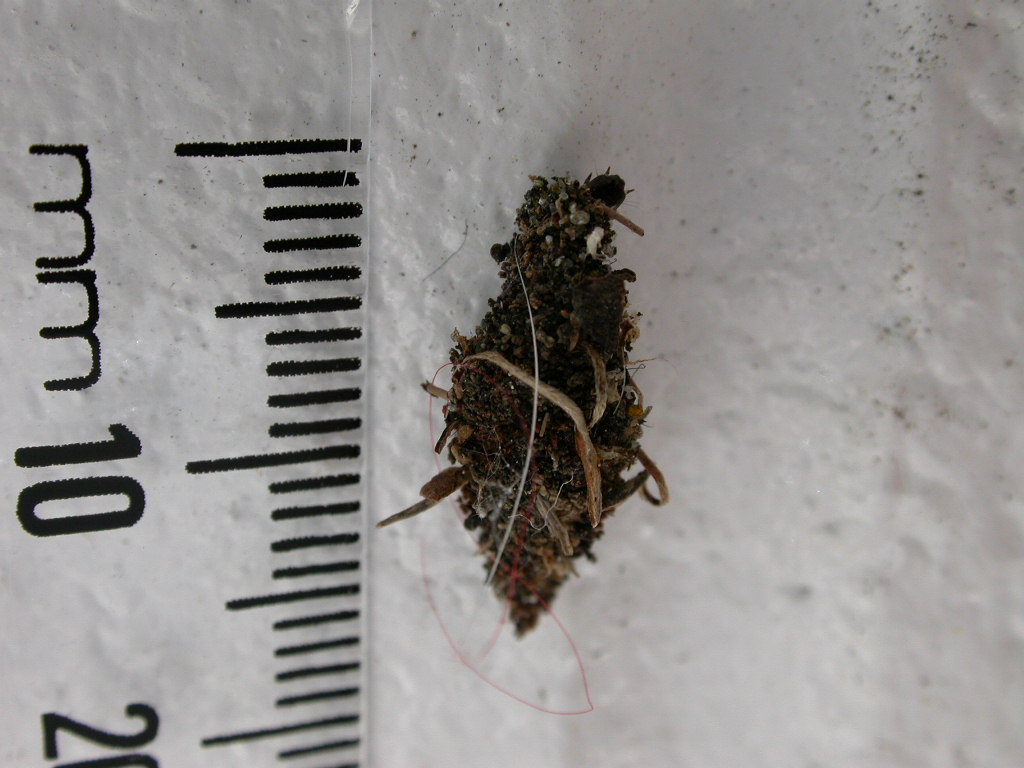
This gorgeous little insect is a female Australian bag moth (Cebysa leucotelus) – in this image she’s sitting on the netting we’re using to keep the late-season cabbage butterflies off our brassicas, but I suspect that normally she’d have been a little harder to spot. After all, from the tips of her antennae to the end of her abdomen, she wasn’t much over 10mm long. At first I thought that I was looking at a brightly-coloured beetle, but Google Lens & i-Naturalist soon put me right. (According to Manaaki Whenua Landcare Research, that misidentification is is quite a common mistake; phew!) You might spot one around yourself, as the peak for reported observations on the i-Naturalist site is in March.
It turns out that this species is quite strongly sexually dimorphic, with males & females being quite different in colouration – and also in flying ability: the female is described as being capable of only short wing-powered “hops”, while the males are free-flying. Larvae construct little “bags” (or cases) out of silk, studded with little pieces of detritus. As you can see, they’d be quite hard to spot in the garden, & I have to confess that I don’t think I’ve ever seen one at our place (though obviously, they’re there). The larvae graze on lichen & algae before pupating, & when the adults emerge they are there for one thing only: to make more bagworms: they don’t eat at all during their short winged lives.

Image source: – Flickr: Cebysa leucotelus https://en.wikipedia.org/wiki/Cebysa_leucotelus#/media/File:Cebysa_leucotelus_case.jpg (CC BY 2.0)
After I posted my photo of the adult moth on Facebook, I had a really interesting conversation with my friend Stella, who’s an expert on native fish but also knows quite a bit about invertebrates. Turns out both bag moths & case moths – you’ve probably seen their elongate “cases” on tree branches – are Psychids (the common names are interchangeable). Stella told me that we have a lot of psychid species in Aotearoa New Zealand – more than 50, in fact – but most of them are tiny micropsychids living in leaf litter. The three bigger bag (or case) moths found here are the tussock bagworm, Orophora unicolor, which is apparently extremely well-camouflaged¹; the more familiar endemic case moth Liothula omnivora (shown below as the larva in its silken case); & the brightly-coloured Cebysa leucotelus.

Image source: – Own work https://creativecommons.org/licenses/by-sa/4.0/ https://en.wikipedia.org/wiki/Liothula_omnivora#/media/File:Bagworm,_Liothula_omnivora.jpg
This final paragraph on Liothula omnivora is from Stella, with her permission; I love the way she describes how the bag is made & decorated. (She also contributed to this page on Liothula.)
Those amazing structures are built by endemic caterpillars. They maintain 100% humidity inside (just what the caterpillar needs so it doesn’t dry out) and are impossible to tear apart, even years after the insect is long gone. The caterpillar started building the bag, as soon as it hatched from the egg, by making a loop of silk then adding more and more loops – a bit like knitting a sock. Since the caterpillar never leaves the bag, to put the decorations on the outside it snuggles down into the bag, bites a slit through the bag, pokes the wee stick or leaf particle out, secures it to one side of the slit, then sews the slit up so perfectly that there is no evidence on the inside that it was ever opened. The caterpillar pupates inside the bag, first turning upside-down. The male emerges as a scruffy, hairy grey-black moth. The female doesn’t even look like a moth. She looks like a soft fat grub. Her abdomen is so thin you can see the tiny eggs inside. She stays safely inside the bag, releasing pheromones to draw the flying males to her.
I’ll be looking more closely around our garden beds in future, trying to spot more bag moths!
¹ The secret to Orophora‘s excellent camouflage, Stella tells me, is that it lives on tussock and disguises its bag with tussock. Apparently your best chance of spotting on is to look for the pupae on non-tussock plants.
